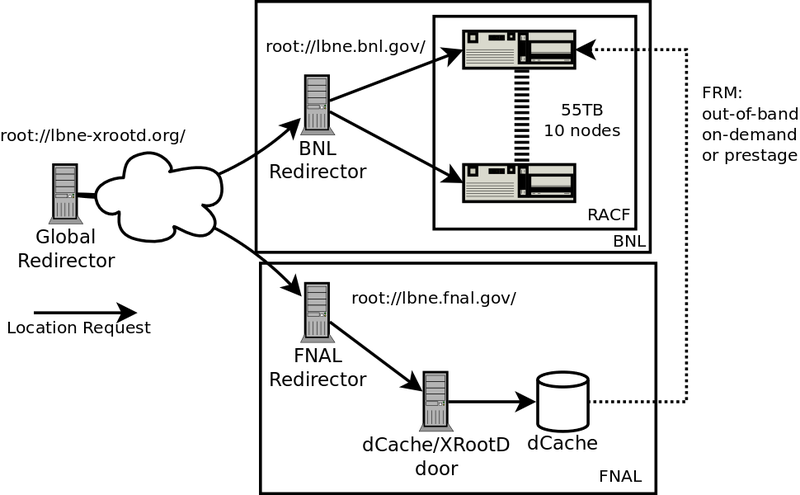DUNE xrootd
Contents
Documentation
dCache/xrootd
- A comprehensive review of dCache/xrootd. This document is quite relevant as it explains how dCache storage at FNAL is equipped with a "xroot door" so that it's exposed to external xrootd servers.
- https://github.com/DUNE/protodune-raw-data-mgt: this repo contains information on the design of the protoDUNE online buffer, and documentation on application of xrootd for that purpose.
Advice to beginners on running a XRootD service
See the Basic XRootD page which contains a few helpful tips on how to install and start running a basic XRootD cluster.
xrootd@BNL
Currently there is a small DUNE Cluster (for historical reason named "lbne cluster") at Brookhaven National Lab under the umbrella of RACF RHIC and ATLAS Computing Facility. The machines have names like lbne0001 etc. Xrootd software is deployed on all of these. To utilize it, the user needs to be authenticated with a X.509 certificate by the xrootd service and authorized to access it by system administrators (please contact Brett Viren or Maxim Potekhin for further information.
Once authorized on the site, the user will need the use the following commands to obtain the Grid proxy:
setenv GLOBUS_LOCATION /afs/rhic.bnl.gov/@sys/opt/vdt/globus source $GLOBUS_LOCATION/etc/globus-user-env.csh grid-proxy-init
...and enter the passphrase as required. This will make sure the user can be authenticated to the xrootd service is allowed to use it.
The following is an example of a shell command that will transport a single file from FNAL to BNL:
xrdcp root://lbnelrd.rcf.bnl.gov//lbne/mc/lbne/simulated/001/singleparticle_antimu_20140801_Simulation1.root \ /tmp/singleparticle_antimu_20140801_Simulation1.root
Possible xrootd architecture for medium term
The idea behind the architecture proposed here is to achieve federation of storage and access to data across a few data centers (e.g. national labs) with modest amount of effort and resources. In this approach, this is effectively achieved by using a "global redirector" which allows xrootd services to locate a particular piece of data within the federation.
Misc
Global Paths
For Xrootd we can have global Xrootd paths like:
root://data.<tbd>.org/path/to/file.root
But, in the future we may want to serve data files on other protocols but in the same domain/namespace. Ie:
http://data.<tbd>.org/path/to/file.root
Since the two are on different ports this should be okay.
Running a minicluster
For basic "basement lab" type of experimentation it's convenient to use a few computers not needed at the moment for other purposes. One should really use ssh to manipulate a few machines from a single host, but if security is not an issue due to the network being strictly local, and the inet daemon is installed, telnet can be used as a quick solution. For example, on Ubuntu a daemon can be started as follows:
sudo /etc/init.d/xinetd start
You may need to add a few applications to your desktop, this is done as follows:
sudo cp /usr/share/applications/firefox.desktop ~/Desktop/ sudo chmod +x ~/Desktop/firefox.desktop
Back to Main Page (DUNE)
Back to DUNE Computing
